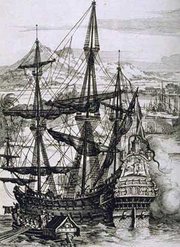Galleon
|
|
- For the fictional unit of money called a "galleon", see Money in Harry Potter.
A galleon was a large, multi-decked sailing ship used primarily by the nations of Europe from the 16th to 18th centuries. Whether used for war or commerce, they were generally armed with cannons.
Galleons were a natural evolution of the caravel and carrack (or nao). A lowering of the forecastle and elongation of the hull gave an unprecedented level of stability in the water, leading to a faster, more maneuverable vessel. The galleon differed from the older types primarily by being longer, lower and narrower, with a square tuck stern instead of a round tuck, and by having a snout or head projecting forward from the bows below the level of the forecastle. In Portugal at least, carracks were usually very large ships for their time (often over 1000 tons), while galleons were mostly under 500 tons, although larger ones were built. Carracks tended to be lightly armed and used for transporting booty from the Far East, while galleons were purpose-built warships, and were stronger, more heavily armed, and also cheaper to build (5 galleons could cost around the same as 3 carracks) and were therefore a much better investment for use as warships.
The galleon was powered entirely by sail, carried on three to five masts. They were used in both military and trade applications, perhaps most famously in the Spanish treasure fleet, and particularly the fabled Manila Galleon. In fact, galleons were so versatile that a single vessel may have been refitted for wartime and peacetime roles several times during its lifespan.
Galleons were constructed from oak (for the keel), pine (for the masts) and various hardwoods for hull and decking. Hulls were usually carvel-built. The expenses involved in galleon construction were enormous. Hundreds of expert tradesmen (including carpenters, pitch-melters, blacksmiths, coopers, shipwrights, etc.) worked day and night for months before a galleon was seaworthy. Due to this, galleons were often funded by groups of wealthy businessmen who pooled resources for a new ship. Therefore, most galleons were originally consigned for trade, although capture by rival nations usually put the galleon into military service.
The most common gun used aboard a galleon was the demi-culverin, although gun sizes up to demi-cannon were possible.
Due to extensive time often spent at sea and poor conditions on board, advanced rigging systems were developed so that the vessel could be sailed home by an active sailing crew a fraction of the size aboard at departure.
The galleon continued to be used until the late 18th century, when the clipper and man of war rendered it obsolete for trade and warfare respectively.
The book The Galleon (1990), Conway Maritime Press, ISBN 0851775662, contains excellent description and commentary on galleons and carracks.
Other types of sailing vessel
Template:Sailing Vessels and Rigsda:Galeon de:Galeone es:Galeón et:Galeoon fr:Galion ja:ガレオン船 pl:Galeon

